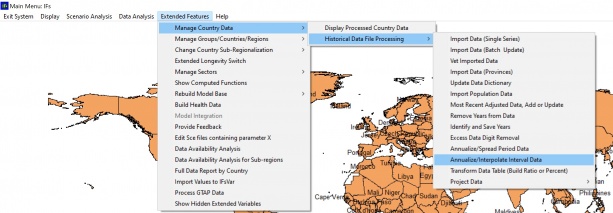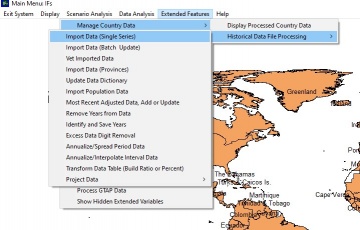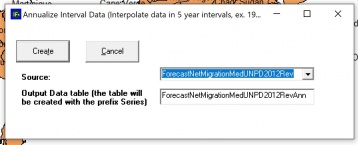World Population Prospects (WPP)
United Nations Population Division: World Population Prospects (The 2002 Revision Population Database)
The 2002 Revision Population Database, annually published by the United Nations Population Division of the Department of Economic and Social Affairs of the United Nations Secretariat, is a comprehensive data source for world population and official estimation of world population and projections. The 2002 Revision is the eighteenth round of global demographic estimates and projections undertaken by the Population Division since 1950. The database provides major demographic indicators like birth rate, death rate, mortality rate, fertility rate etc. for each member country of United Nations for 1950-2050 by age and sex of the population. This database provides demographic distribution for 20 age-cohorts by sex. In all datasets, figures for 1950-2000 are estimates and those for 2000-2050 are projections. In case of projection, the database has been organized in four sets of variants: low, medium, high, and constant. Thomas Buettner of the Population Division was kind enough to provide data from the 2002 revision to the IFs project.
| Table | Group | Definition | Source | Last IFs Update | UsedInPreprocessor | Years |
|---|---|---|---|---|---|---|
| SeriesForecastPopConstantFemaleUNPD | Population | Constant-fertility variant female population by country, annually for 2010-2100 (millions) | United Nations, Department of Economic and Social Affairs, Population Division (2011). World Population Prospects: The 2010 Revision, CD-ROM Edition. | 10/2012 | No | |
| SeriesForecastPopConstantMaleUNPD | Population | Constant-fertility variant male population by country, annually for 2010-2100 (millions) | United Nations, Department of Economic and Social Affairs, Population Division (2011). World Population Prospects: The 2010 Revision, CD-ROM Edition. | 10/2012 | No | |
| SeriesForecastPopConstantTotalUNPD | Population | Constant-fertility variant total population (both sexes combined) by country, annually for 2010-2100 (millions) | United Nations, Department of Economic and Social Affairs, Population Division (2011). World Population Prospects: The 2010 Revision, CD-ROM Edition. | 10/2012 | No | |
| SeriesForecastPopHighFemaleUNPD | Population | High-fertility variant female population by country, annually for 2010-2100 (millions) | United Nations, Department of Economic and Social Affairs, Population Division (2011). World Population Prospects: The 2010 Revision, CD-ROM Edition. | 2012/10 | No | |
| SeriesForecastPopHighMaleUNPD | Population | High-fertility variant male population by country, annually for 2010-2100 (millions) | United Nations, Department of Economic and Social Affairs, Population Division (2011). World Population Prospects: The 2010 Revision, CD-ROM Edition. | 2012/10 | No | |
| SeriesForecastPopHighTotalUNPD | Population | High-fertility variant total population (both sexes combined) by country, annually for 2010-2100 (millions) | United Nations, Department of Economic and Social Affairs, Population Division (2011). World Population Prospects: The 2010 Revision, CD-ROM Edition. | 2012/10 | No | |
| SeriesForecastPopLowFemaleUNPD | Population | Low-fertility variant female population by country, annually for 2010-2100 (millions) | United Nations, Department of Economic and Social Affairs, Population Division (2011). World Population Prospects: The 2010 Revision, CD-ROM Edition. | 2012/10 | No | |
| SeriesForecastPopLowMaleUNPD | Population | Low-fertility variant male population by country, annually for 2010-2100 (millions) | United Nations, Department of Economic and Social Affairs, Population Division (2011). World Population Prospects: The 2010 Revision, CD-ROM Edition. | 2012/10 | No | |
| SeriesForecastPopLowTotalUNPD | Population | Low-fertility variant total population (both sexes combined) by country, annually for 2010-2100 (millions) | United Nations, Department of Economic and Social Affairs, Population Division (2011). World Population Prospects: The 2010 Revision, CD-ROM Edition. | 2012/10 | No | |
| SeriesForecastPopMediumFemaleUNPDe | Population | Medium-fertility variant female population by country, annually for 2010-2100 (millions) | United Nations, Department of Economic and Social Affairs, Population Division (2011). World Population Prospects: The 2010 Revision, CD-ROM Edition. | 10/2012 | No | |
| SeriesForecastPopMediumMaleUNPD | Population | Medium-fertility variant male population by country, annually for 2010-2100 (millions) | United Nations, Department of Economic and Social Affairs, Population Division (2011). World Population Prospects: The 2010 Revision, CD-ROM Edition. | 10/2012 | No | |
| SeriesForecastPopMediumTotalUNPD | Population | Medium-fertility variant total population (both sexes combined) by country, annually for 2010-2100 (millions) | United Nations, Department of Economic and Social Affairs, Population Division (2011). World Population Prospects: The 2010 Revision, CD-ROM Edition. | 10/2012 | No | |
| SeriesForecastPopUrbanUNPD | Population | Urban Population by Country, 1950-2050 | United Nations, Department of Economic and Social Affairs, Population Division (2012). World Urbanization Prospects: The 2011 Revision, CD-ROM Edition. | 10/2012 | No |
Instructions on Annualizing WPP Population Data
Several of the WPP Population series are given in averages or sums every 5 years.
To provide values for the missing years, IFs has a built in “Annualize” feature under Extended Features>Manage Country Data>Historical Data File Processing.
There are two different functions:
- Annualize/Spread Period Data (Use this if the raw data values represent the sum of data for all years contained in the interval. The data will then be spread across the 5 years.)
- Annualize/Interpolate Interval Data (Use this if the raw data values represent the data for only one given year. In this case the missing years will be interpolated across the missing years.)
In order use the Annualize functions in IFs, complete the following steps:
1. Format raw data in excel
2. Import Excel Data to an access file using IFs>Extended Features>Historical Data File Processing>Import Data
3. Copy Series Table from access file Local Disk (C:)>Users>Public>IFs>DATA>IFsDataImport and paste in Local Disk (C:)>Users>Public>IFs>DATA>IFsHistSeries
4. Copy the corresponding row from the DataDict Table in access file “Local Disk (C:)>Users>Public>IFs>DATA>IFsDataImport” and paste in “Local Disk (C:)>Users>Public>IFs>DATA>DataDict”
5. Annualize data in IFs: Extended Features>Manage Country Data>Historical Data File Processing>Annualize/Interpolate Data OR Annualize/Spread Data
a. Select source name that matches the table you pasted in IFsHistSeries
b. Use a unique name for the Output Data table so you can differentiate the annualized version
- note that the Source series must be included in both IFsHistSeries and DataDict tables, otherwise it will not show up as an option for annualizing
6. Compile all annualized tables in a new access file, include data dict table, and be sure series names match


